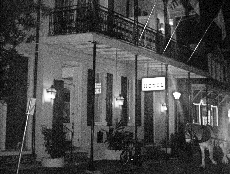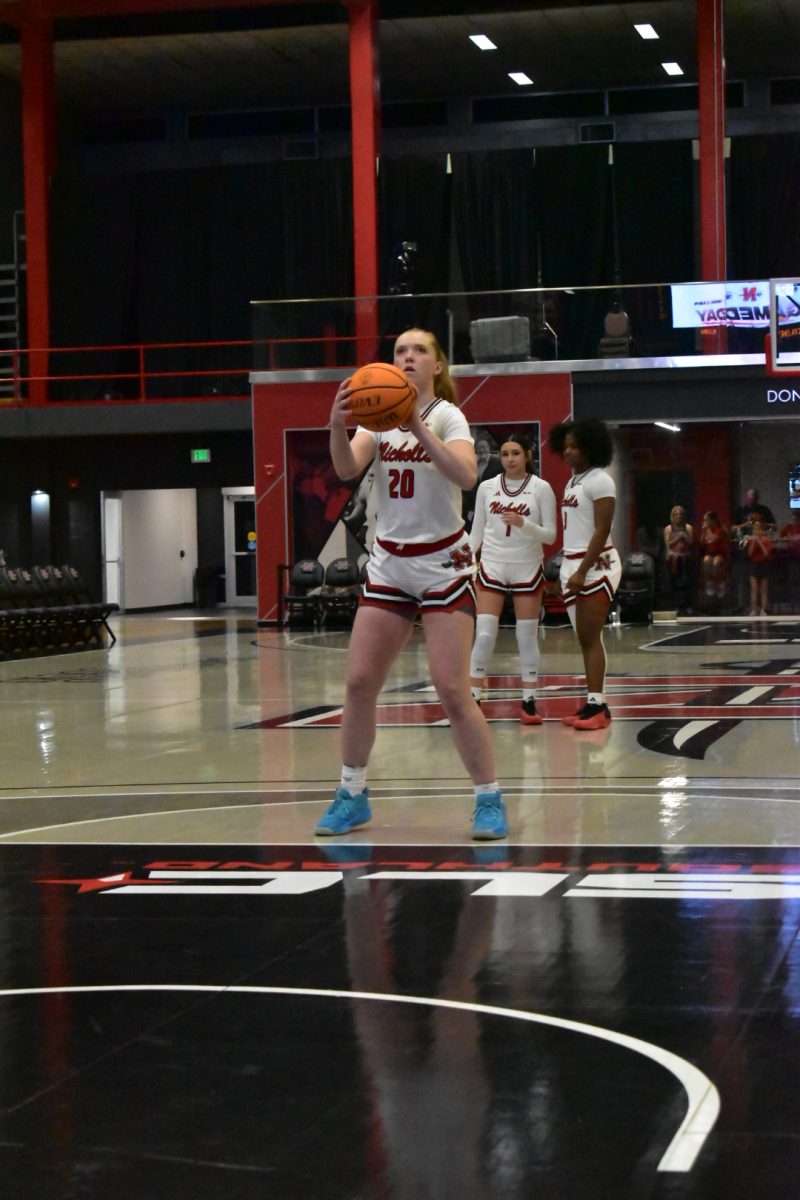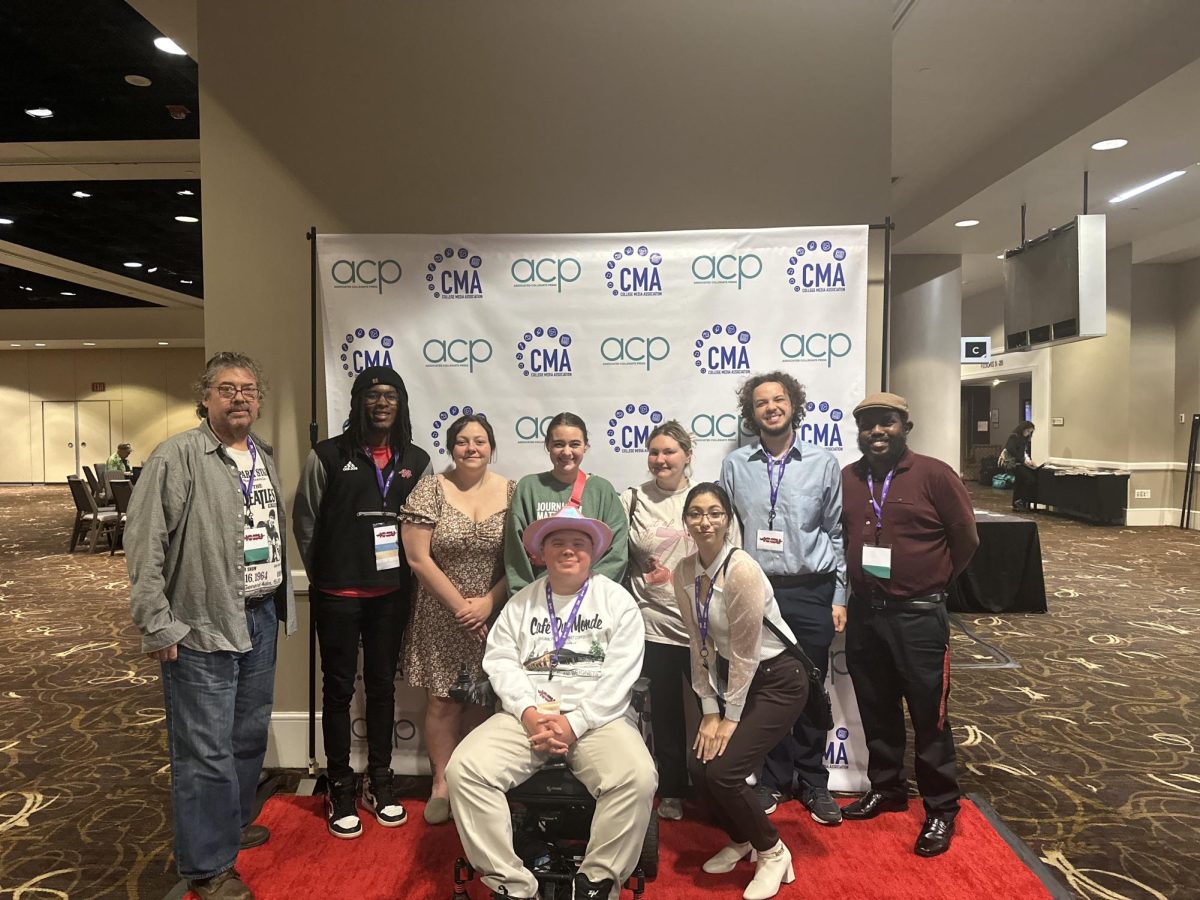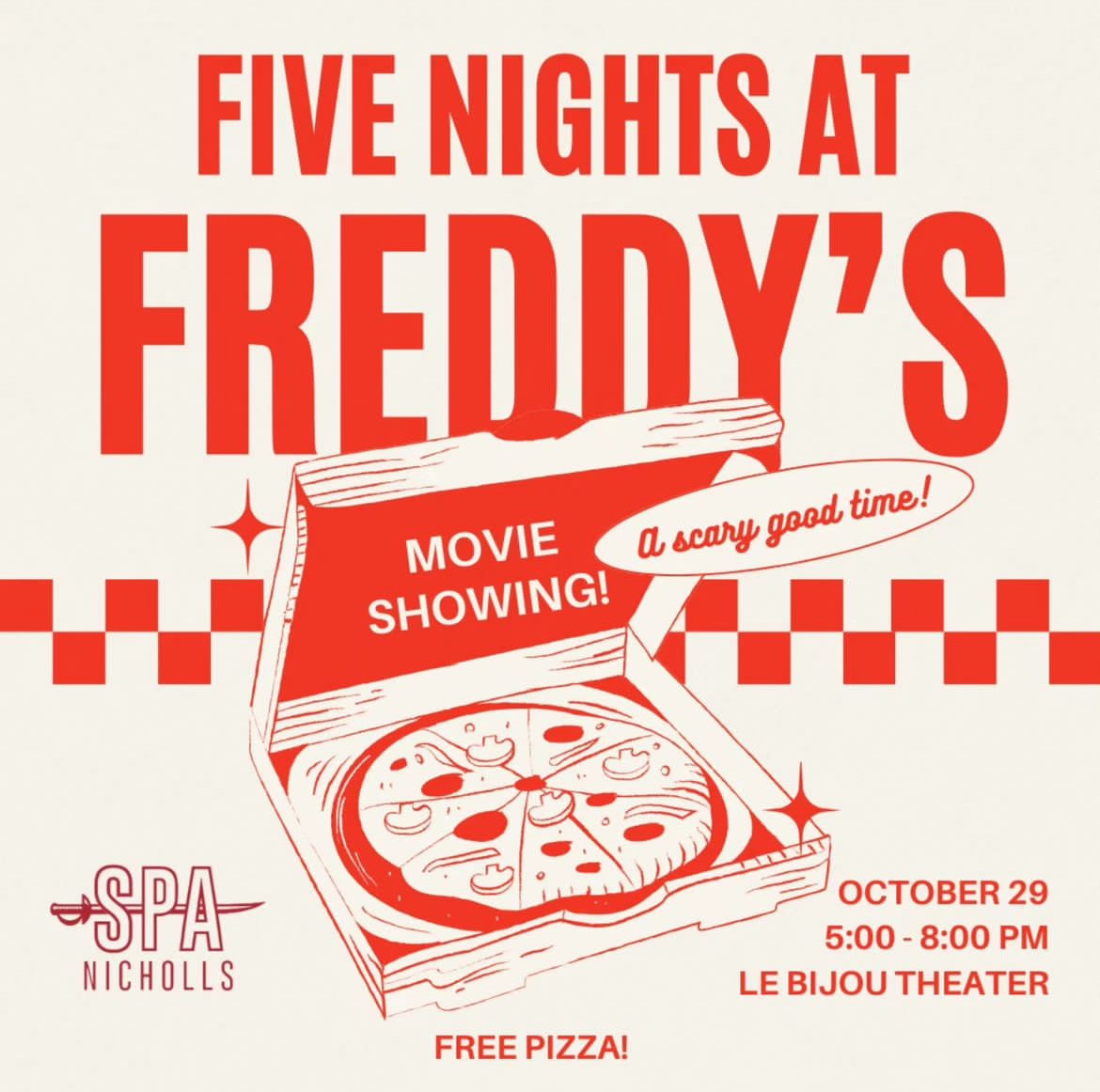A horse-drawn carriage filled with spectators rumbles down the busy street. The lively sound of a Zydeco band fills the air. Two middle-aged women stumble out of Pat O’Brien’s, laughing. Across the street at Rev. Zombie’s Voodoo Shop, tribal masks, religious statues and skeletons decorate the part-store, part-spiritual haven. Hanging from the roof of a nearby store, a sign reads, “Welcome visitors- the French Quarter is a neighborhood.” In front Rev. Zombie’s Voodoo Shop, a two-sided black and white gothic-style sign reads, “Haunted History Tours.” It’s 6 p.m. on a Saturday night, and a crowd seeking excitement and a chilling narrative has gathered.
“I’m gonna split this group in half,” Bill, one of the tour guides, yells. After introducing himself to the crowd, he instructs the group to say, “Hi, Bill.”
“Hi, Bill,” the crowd sings back.
“Excellent. It reminds me of the meetings,” he says with a hint of sarcasm.
Among the crowd are college students wearing flip flops, an elderly woman whose eyebrows are drawn on, tourists from New Mexico wielding shopping bags and a little girl whose face is painted. After an outspoken teenage girl yells profanities, she apologizes to the rest of the group: “I don’t mean to be offensive, but I’m getting drunk.”
The other tour guide, Eugenia, leads her group away from St. Peter Street and down a block, where she delivers the rules for the walking tour. She warns her group that under the Napoleonic Code in New Orleans, pedestrians do not have the right-of-way. “We also have a very high DWI rate,” she informs them. “Shocking, I know.”
The first stop on the tour is the Place d’Armes Hotel near the St. Louis Cathedral. On Good Friday in 1788, after a fire ignited in the French Quarter home of a Spanish military treasurer, 856 buildings in New Orleans – four-fifths of the city- were set ablaze. Among them is New Orleans’ first school, now the Place d’Armes Hotel, which burned with students and the headmaster still inside.
It is said that a dark-haired, mysterious, debonair man wearing a dark suit strolls around the Place d’Armes on certain occasions. He’s an apparition- the headmaster of the ruined school. Or at least that’s what some believe.
The second stop is the Hotel Provincial. As a Civil War hospital, the decor of the treatment center was blood and limbs. “During that time, if you took a bullet you were pretty much going to get something cut off,” Eugenia informs. “It was easier – they could make that cut in seconds flat, cauterize the wound with a frying pan and send you on your way to manage your pain how you best saw fit, as you didn’t get any anaesthesia.”
When anaesthesia is not being administered, time is essential. “In order to (be quick), you had to be a big, strong guy because it’s not easy sawing through people,” Eugenia says. A few members of the group laugh at her dry humor.
The strong men who cut off soldiers’ wounded body parts would not wear scrubs like surgeons wear today but would rather be dressed in brown leather aprons and brown masks. “A lot like a butcher,” Eugenia says. “And they had to saw- a lot like a butcher.”
The hotel’s maids say sometimes when they go to clean a bathroom, blood will cover the sink. A moment later, it vanishes. “(The maids) go to make the beds, and there’ll be blood on the sheets. A moment later, it’s gone,” Eugenia says.
“If you’re a maid at a hotel in the French Quarter, you’re going to see a lot – this worldly and other-worldly,” she jokes.
Another haunting story is from when a man with sleep paralysis stayed at the Hotel Provincial. The man’s mind could wake up and his eyes could see, but his body would stay immobile after first waking. “He had an episode at the hotel, during which he saw a large man in a brown, leather apron and a brown mask proceed to saw off his leg,” she tells the group. “He left as soon as he could wake up the rest of his limbs.”
The tour winds around more streets of the scenic, Spanish-style French Quarter and arrives at the LaLaurie Mansion. Across the street from the mansion, running parallel with the sidewalk, are fences that guard elaborate homes from intruders – some lined with iron spikes at the top, some lined with plates of jagged, multi-colored glass. “This is the one you’ve all been waiting for – the haunted house of New Orleans,” Eugenia says with delight. The massive residence on Royal Street is gray with black posts supporting it, and black shutters and white trimming accent it. The sobering colors are appropriate for the LaLaurie Mansion and its grim history.
The story begins in 1834 when it was the home of Louis and Delphine LaLaurie. The couple were socialites in New Orleans, Delphine being “old money” and Louie being a doctor. “Louie was her third husband,” Eugenia says. “One and two died mysteriously.”
By 1834, many forms of entertainment and leisure were available to people in New Orleans. The locomotive and the steam boat had been invented, and New Orleans had the largest port in the country.
“We (the people of New Orleans) are booming,” Eugenia says. “We are the creme de la creme of towns. In the Garden District, we have more millionaires than anywhere else in the country.”
During this vibrant period in New Orleans’ history, the couple became notorious for throwing the best parties in town. Delphine develops a reputation for disappearing in the middle of her elaborate parties and returning in a completely different gown. Her guests considered this rude because a hostess was not supposed to leave in the middle of her party, and in addition, it was inconsiderate of her to show off more than one dress per night.
On one occasion, one of Delphine’s slaves, a girl about 12 or 13 years old named Leah, was combing Delphine’s hair when she caught a snag. “Rather than be a good little girl and tease it out gently, she just rips it out,” Eugenia narrates. “Delphine is furious and takes a bull whip and proceeds to beat that girl down the hallway unto the interior balcony. And that little girl goes ‘splat’ into the courtyard.”
In the code Bienville established when he founded New Orleans, he defined proper and improper behavior towards slaves. “You couldn’t beat them, and you surely couldn’t kill them,” Eugenia informs the group.
“It was reported to the sheriff, and Delphine was made to pay a fine, which would have been a whole lot of money to anyone else in town,” Eugenia tells the crowd. “She was made to give up her slaves, which she gave to her family, who promptly returned them to her.”
Later in 1834, during one of Delphine’s extravagant parties, a fire ignites in the kitchen. Because the kitchen is separate from the mansion, her guests are not alarmed and wait outside until the fire is put out and they can return to their debauchery.
The firemen extinguish the flames, but inside the kitchen find a slave woman chained by her ankles to the wall. “She tells the firemen, in her very broken French, that she set the fire deliberately because she would rather burn up in the house than live in it with what was going on upstairs,” Eugenia says. “She said people went upstairs and never came back.”
The firemen discover the door to the slaves’ quarters- a large, heavy, wooden door with a bar across it, unlike any other door in the mansion. “They go to beat down the door, and as it starts to open up, the stench of death starts flooding in behind it, so much so that they had to spend 20 minutes vomiting outside the door before they could finally get it together to go in,” Eugenia says.
“The sheriff comes by and says, “Ok boys, get your courage, get your hankies- we’re going in there,” Eugenia continues. In the dark, cavernous room, the firemen and the sheriff witness torture.
Some slaves were chained up, and all had “medical” experiments performed on the
m. One girl was chained, but seemed to be physically unharmed. The firemen unchain her, hoping to have a witness. But the girl bolts, screaming, and runs through the window, falling onto the sidewalk, in the middle of the party that had reassembled outside.
“Everybody heard about the horrors going on at the LaLaurie Mansion and figured they knew why she would disappear in the middle of her parties and come back later in a different dress,” Eugenia says. “They were convinced she was so blood thirsty that she needed a fix, even in the middle of a party.”
The couple escapes before the sheriff can obtain a federal warrant for their arrests, and they are never seen or heard from again. “[The LaLaurie Mansion] becomes the haunted house of New Orleans,” Eugenia says. “No one wants to go near it. People say they hear thumping and moaning and scratching and howling and cries coming from inside. People don’t walk on that side of the street; some avoid the whole street.”
30 years later, the mansion is transformed into a debutante finishing school and then promptly closed after the girls started seeing, “…a crazy woman with a bull whip, chasing them down the
halls, cursing them in French.” For a time it is rented to Sicilian immigrants, but when some complain about finding their pets disemboweled in the courtyard, the tenants move out.
The mansion was then bought by a plastic surgeon who had it renovated. “He had the floors in what had been the kitchen pulled up, and hundreds of human bones were found. The thumping, scratching and howling soon after the LaLauries left was not of dead people- at first.”
As the night grows darker, the group arrives at the final stop on the tour- Andrew Jackson Hotel. Also located on Royal Street, this yellow inn with blue shutters served as a boarding school for Spanish boys in the 18th century. The building was not damaged in 1794 when New Orleans experienced its second great fire, but five young boys from the school were lost and died in the fire.
One night a couple staying at the hotel put the television on CNN, Eugenia narrates. After the television channel kept switching to the Cartoon Network, the couple gave up and left. Early the next morning, the couple noticed they had only three pictures left on their camera. Because they were going on a swamp tour the next day, they put another roll of film in their bag. When the couple took their camera out to take a picture at the swamp tour, they noticed all the film had been used. Dismissing the situation, they put in the other roll of film.
“They go home and get their film developed,” Eugenia says. “They have pictures of alligators and swamps and Cypress trees, Bourbon Street, passed out transvestites and horse-drawn carriages- and three pictures of themselves asleep in bed.”
As the tour continues, the night becomes colder. There is less conversation among the once-talkative group. As the aged buildings cast shadows upon the streets, the tour group seems dazed. Some are contemplating whether spirits are real; some, perhaps, are trying to shake a disturbing image of a tortured slave out of their heads. Others are unconcerned with the ghost stories and are planning where they will party that night.
But others imagine what New Orleans would have been like during the 18th and 19th centuries. They see the fires that ripped through the city and the extravagant balls held five to six times a week. A time when everything was slow-paced and leisurely. A time of war, bloodshed and captivity. Could the spirits of people interact with the living?
Some tourists are unchanged, but others leave believers.








